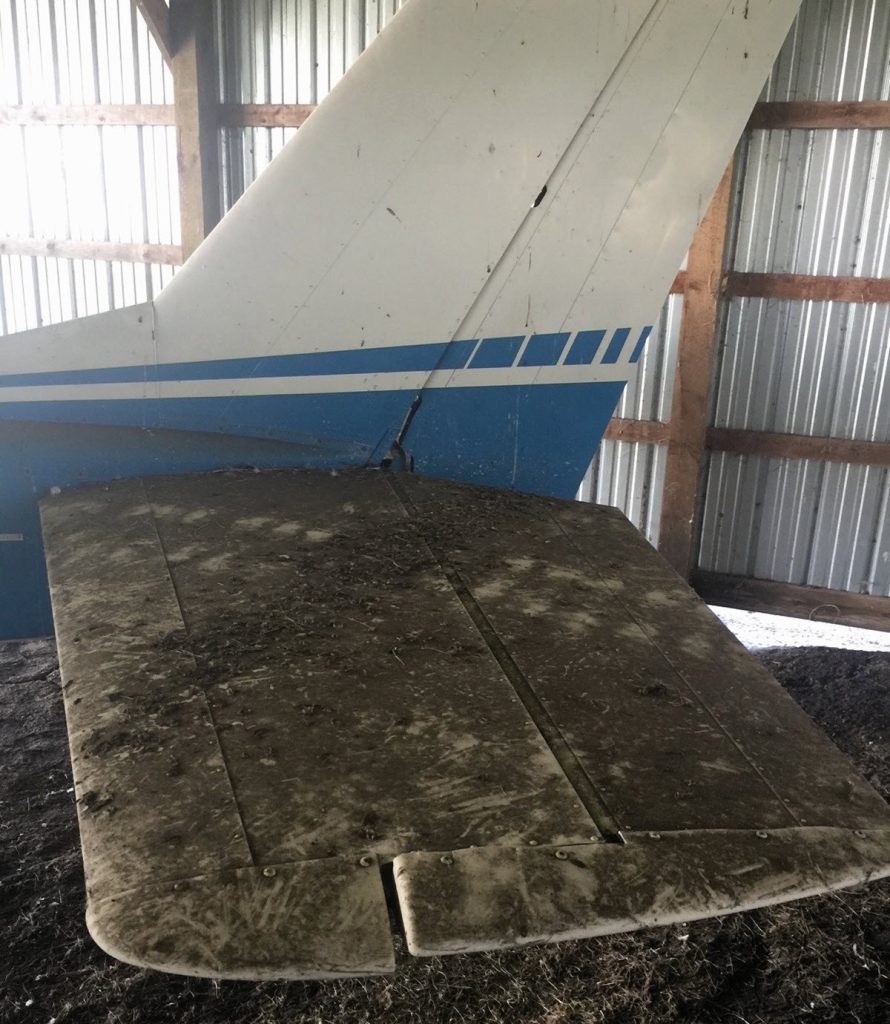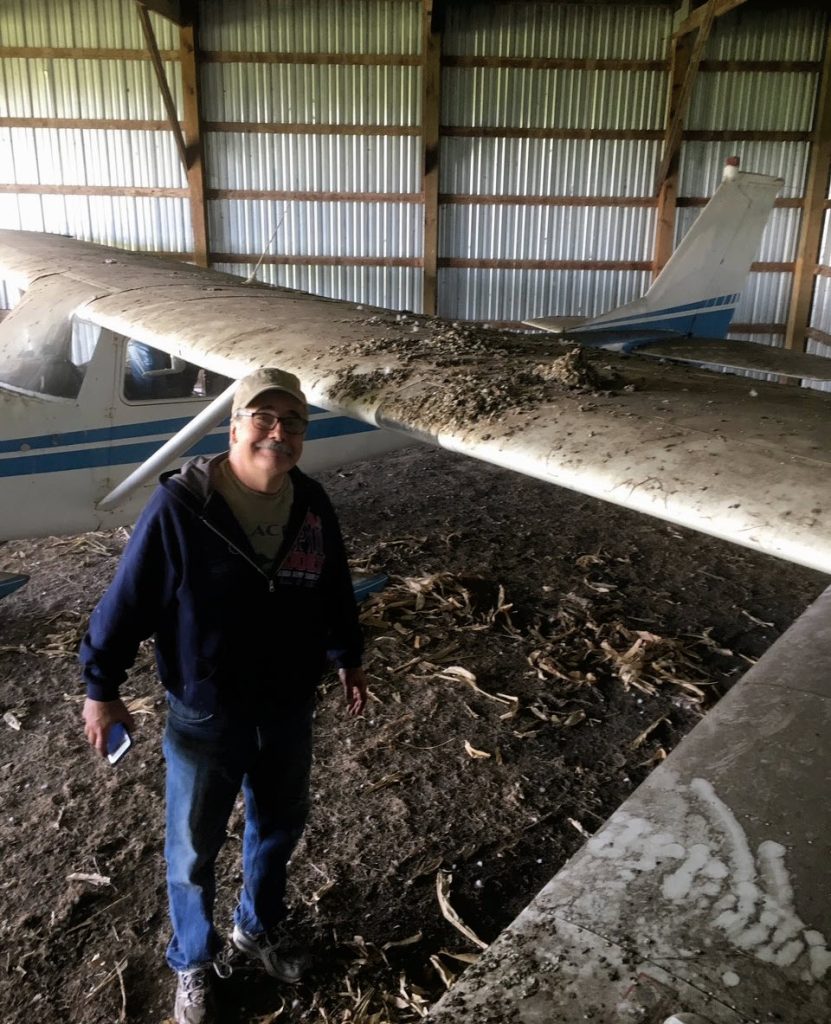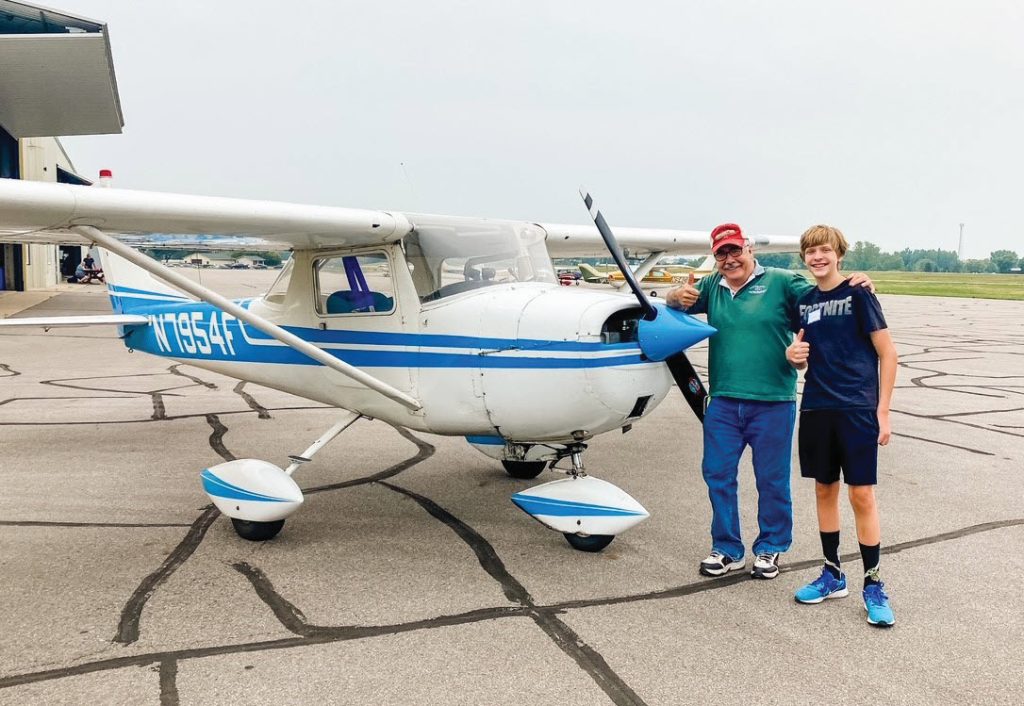By Doug Garin and Paul Clark
Well before the 9/11 attacks, before the space shuttle explosion and sometime during the Clinton Presidency, a not-so-tired, Continental-powered, cute little white and blue Cessna 150 was parked in a deserted spot, at the back of an old hangar in Battle Lake, Minnesota. And there it sat. Don’t know why and doesn’t matter by who because this is the story of the 150 and her resurrection.
Battle Lake airport is a grass strip in a beautiful historic town adjacent to the lake within the typically-treed landscape of Northern Minnesota. If the plane could talk from the back of that doorless hangar, she’d tell you of Minnesota’s many colorful seasons, the airplane takeoffs and landings and the various airport social activities happening just beyond her reach – only a memory for her.
I’d heard stories about the abandoned little bird from the occasional, transient pilot over the years. I always wondered if she truly existed. So, one day I jumped in my trusty Beechcraft Sport and flew up there from Alexandria, MN airport (KAXN). After taxiing up on a perfectly groomed grass strip, I parked next to the oldest-looking hangar I could find and walked in, or should I say walked back into time.
Oh my gosh, there it was! The little Cessna 150 sat in the back of the opened hangar. I strained to get around a long-time abandoned and stripped out Stinson 108, while knee deep in weeds with barn swallows diving over my head to get a look at the 1966 Cessna 150. Like the backroads motorist noticing the old Buick abandoned in the farmers field full of brush, I spied this old abandoned bird. Her wings had 2-6 inches of barn swallow dung (if that’s what you call bird poop) on them. Her windows were so full of dirt you couldn’t see out of them. The tires were of course flattened, the paint dulled, and the interior was crusted up with settled dirt. And there was an un-pickled engine that most assuredly needed major work. I mean, it’s not like I just discovered an old Beechcraft Stagerwing or something. This was a common, everyday two seat 1966 Cessna 150. But something told me she had a purpose and needed to be brought back to life.

Cleaning Up “Dirty Bird”
Hence the beginning of her resurrection. I spread the word. With the help of many Alexandria Airport aviation enthusiasts, we began the sometimes-awkward process of airplane rejuvenation.
The plan was to resurrect the bird, sell it and contribute the profits to the local EAA or the local airport for an aviation scholarship. After hours of researching the owner and negotiating a fair price, it was time to find volunteers for the project and get to work. There certainly was a contingency of aviation enthusiasts willing to take the project on but, surprisingly, an opposing minority of guys pointed out the negative aspects of the endeavor and questioned whether it was worth the trouble.
In the end, the enthusiasts prevailed. We wanted this bird to fly! So a few weeks later, about eight of us found ourselves spending a sunny day at the grass strip cleaning and removing the wings for transport. Someone donated a lowboy trailer, truck, and fuel to our cause.
The cleaning proved to be a bigger challenge than we expected. Thus, one of the volunteers coined the name “Dirty Bird” for the Cessna. I don’t know if the bird or I appreciated that name, albeit a fitting description at the time. So we went with it.
The Restoration Process
Moving ahead, our local A&P mechanic oversaw our work on the airframe, at a more than fair fee, while an out-of-state A&P shop let us help with the engine rebuild, which turned out to be a higher-than-expected cost. I know the “unexpected cost thing” is well understood in the aircraft ownership community but, nonetheless, it seriously challenged our bottom line for the project.
During the rebuild process, several volunteers expressed their appreciation for the knowledge they gained about the inner mechanical workings of an airplane. (Two of them were so enthused about the project, they purchased their own airplane a short time later). We had dads, kids, grandpas and grandmas and the usual curious aviation enthusiasts working at their own pace. From tip to tail, we looked at everything. And if there was any question on the condition of an item, we replaced or repaired it.
Some of the self-proclaimed, non-mechanically inclined individuals went hard to work on cleaning, buffing and waxing the wings and fuselage to gain a respectable shine on the original paint. In fact, they did such a good job the name “Dirty Bird” just had to go. No suitable replacement name has yet to surface. Any ideas are welcome at this time. As the costs started to run over original estimates, we did our best to trade up on instruments, radios and upholstery items to give her the best look we could.
Finally, a little more than a year later, the girl was given a thorough A&P checkup and found fit for flight. Having been elected chief test pilot on the initial flight (running unopposed), I taxied out on Runway 31, preparing for liftoff on a quiet autumn morning with moderate winds and clear skies. Now, I know this is a fully certified, general aviation Cessna 150 and not a new Air Force stealth fighter. Still, I had butterflies. I had a brief discussion with myself on the hold short line. “Push the throttle forward. Enough thinking already!” And off we went.
It had been many years since I’d flown a 150. I forgot just how fun and light on the controls these little birds are. There are few things more rewarding than the first flight on rebuilds or home built airplanes. Knowing you’ve had these bundles of aluminum, steel and plastic apart and reworked them into a machine that actually takes you above our earthly bonds is nothing short of a spiritual experience to some.
The Cessna 150’s Mission
Completing our flight tests, the group’s focus became deciding how to put this bird to good use. Our original goal of selling the rejuvenated aircraft for a donatable profit had long since faded away due to the cost overruns. So, we had to explore other ideas.
I always thought the EAA Young Eagles program was an amazing first step to inspire passion in young, potential aviators, but then what? We can do our best to get young people all fired up with their first flight but when they look at the cost of flying, many realize it’s too expensive for them to even consider. So, how about exploring ways to keep costs down for those unable to afford the new plane or rental fees? This is not meant to be a bash on FBO airplane rental costs or manufacturers. We all know they struggle with operation costs that easily justify the $100+ per hour rates. But the question remained, how could the group give back to our local flying community and perhaps add to the legacy of the little 150?
After much consideration, myself, our airport manager and a friend decided the best way to give back, and perhaps move Young Eagles to the next step, was to form a non-profit, affordable flying club with the 150. With some excellent guidance from EAA resources, we created the Vikingland Flying Club. Now the once “Dirty Bird” proudly displays the club’s logo on her tail. To date, we’ve had as many as nine members at the controls, one of which earned his commercial license and went on to become a commercial pilot, flying commuters to the Bahamas. The others are mainly using it as either a first step toward ownership or just for the fun of flying it.
Finally, many thanks go out to the volunteers, the donors and the flying club members that helped take the old “Dirty Bird” out of the lonesome hangar and into the home she deserves – the sky!






